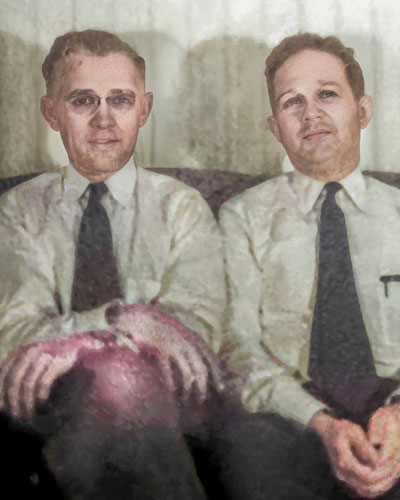Neil’s Musings On Native Plants
So, this past Sunday, May 16, at 6:22 p.m. I posted what you’re about to read on my Facebook page. It’s something I’ve wanted to write for the 11 years that I’ve been on FB. I just never took the plunge before.
There was something this time, however, that put me past the limit. Too many people had pushed too hard on using “native Texas plants” as replacements for landscape plants that had been lost due to cold.
I had been brought up and taught by two masters – two men who knew plants better than I ever will. They happened to be brothers, and that’s where I began my post on Facebook. I hope you enjoy it.

Meet the Sperry brothers. My dad, Dr. Omer E. Sperry on the left (I’m adopted, so don’t bother trying to see the resemblances) and my uncle Dr. John J. Sperry on the right.
Both PhDs in Botany from the University of Nebraska. Both professors at Texas A&M for more than 25 years. My dad taught Range Management and Uncle John taught Botany and Plant Taxonomy. Conversations over Thanksgiving dinners were music to young Neil’s ears!
I traveled all over Texas with my dad as he worked with sheep and goat raisers researching herbicides to control plants that were toxic to livestock. Marfa, Pecos, Sterling City, Cuero, Mountain Home, Kerrville, Leakey, Uvalde, Big Bend National Park – I fell in love with my state, and I brought plants back to College Station to grow in my gardens.
But Dad, trying to cushion my enthusiasm, always said, “Neil, a plant is only ‘NATIVE’ where you find it growing. It may not be ‘ADAPTED’ to the conditions a quarter-mile away.” (Or in soggy College Station – you’ll notice that all of those towns are in more arid areas.)
• He showed me lantanas and cenizas thriving and blooming on the sunny south sides of the hills between Uvalde and Camp Wood, while beautiful little xeriphytic ferns were growing tucked back into rocks on the more shaded north sides of the same hills.
• And cattails and columbines growing 10 feet from yuccas and agaves in Big Bend National Park.
• And loblolly pine trees growing just east of College Station on the road to Huntsville – when I struggled to grow them in our backyard.
If February 2021 taught us anything about gardening here in Texas, it ought to be that the term “native plants” isn’t the golden key to the landscaping universe. Just because a plant is native somewhere in Texas, that doesn’t ensure that it will grow anywhere else.
In this case, I’m going to speak from what I’ve witnessed where I live – in DFW. Please don’t feel like you need to compare your observations from other parts of the state. I’m just saying that these native plants did not do well in many of the Metroplex landscapes I’ve seen:
• Agaves (century plants) were the first to go. They melted as if they’d been boiled.
• Wax myrtles are, for the most part, lost. They don’t do well in our area anyway, and this winter pretty well finished them off.
• Texas sages (ceniza) were badly wounded. Some are dead. Many have lost big portions of their top growth. A few look tolerable. This is the 4th or 5th time that I’ve seen them battered in the 50 years that we’ve lived in the Dallas/Fort Worth area. Soggy soils also take a toll on them. Their native homes in Southwest Texas are dry and well-draining.
• Carolina jessamine vines all froze – at least all that I’ve seen in DFW. This one surprised me. This was the first time that I’ve seen this East Texas native be hurt like this by extreme cold.
• Texas mountain laurel is often hurt by the cold, although they seemed to survive better this year than most. But it also can’t handle waterlogged soils.
And there are others.
I’m not counting oaks in any of this because I believe they’re going to be fine for the most part. The Texas A&M Forest Service advises that we leave them alone. And I’m not including trees like sweet gums and bald cypress which, even though they’re native, aren’t well suited to alkaline soils from I-35 westward.
So, my takeaway from all this, learned from two fine teachers who were in college almost 90 years ago learning the same lesson that we need to learn now: Just because a plant is native somewhere in Texas, that doesn’t guarantee that it will be a good choice for your landscape.
The word ADAPTED will serve you much better when you go garden shopping.

